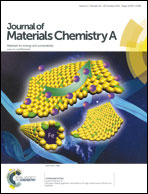Double D–π–A branched organic dye isomers for dye-sensitized solar cells†
Abstract
Three double D–π–A branched organic dye isomers (D1, D2, and D3) with octyloxy bridge linked at different positions of the π-bridge in the D–π–A branch have been designed and synthesized for dye-sensitized solar cells (DSSCs). Their photophysical, electrochemical, and photovoltaic properties were further investigated. Compared with the reference dye isomers containing single D–π–A branches, the double D–π–A branched dye isomers consisting of two separated light-harvesting moieties in one molecule are beneficial to photocurrent generation. Moreover, the cross structure of the double D–π–A branched organic dye isomers is superior to the rod structure of the dye isomers with single D–π–A branches in the suppression of intermolecular interactions, which results in reduced charge recombination rates in the DSSCs based on double branched organic dye isomers. Therefore, in comparison to the DSSCs based on isomeric dyes with single D–π–A branches, the DSSCs based on double branched organic dye isomers display both improved short-circuit current and open-circuit voltage. Furthermore, similar to the single D–π–A branched organic dye isomers, those isomeric dyes with double D–π–A branches exhibit slightly different photophysical properties, which result in the varied photovoltaic performance. The highest power conversion efficiency of 8.1% and 6.9%, respectively, is achieved for isomer D1 based DSSC with liquid and quasi-solid-state electrolyte under simulated AM1.5G solar irradiation (100 mW cm−2).


 Please wait while we load your content...
Please wait while we load your content...